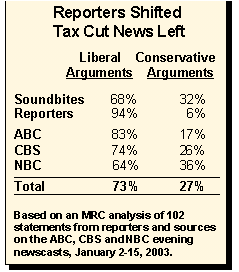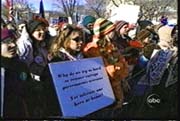Still Liberal, Still Biased
Table of Contents:
January
Reporters Pushed Spin of Anti-Tax Cut Liberals: On January 7, President Bush proposed a new round of tax cuts designed to boost the beleaguered stock market and provide a stimulus to the slow-growing economy. In spite of the weak economic environment, an MRC study found network reporters displayed their classic bias against tax cuts by emphasizing the arguments of tax cut opponents.
 Media Research Center analysts studied all
28 tax cut stories on the ABC, CBS and NBC evening newscasts from
January 2 through January 15, 2003, the two weeks surrounding the new
tax cut plan’s debut. The study found ABC, CBS and NBC gave three times
more airtime to liberal arguments against Bush’s tax cut than to the
conservative arguments for it.
Media Research Center analysts studied all
28 tax cut stories on the ABC, CBS and NBC evening newscasts from
January 2 through January 15, 2003, the two weeks surrounding the new
tax cut plan’s debut. The study found ABC, CBS and NBC gave three times
more airtime to liberal arguments against Bush’s tax cut than to the
conservative arguments for it.
There were three main elements to liberals’ critique of Bush’s tax cut plan. First, they argued that tax cuts were a poor way to stimulate the economy. Second, they claimed that tax cuts would worsen the budget deficit. Lastly, they condemned the tax cut for supposedly only aiding the rich.
The three evening newscasts showed 58 sound bites from politicians, activists or others making one of these three liberal attack points, compared with 27 sound bites from conservatives rejecting these assertions, a greater than two-to-one liberal skew. When TV correspondents themselves weighed in, they sided with liberals another sixteen times, while only one journalist offered an argument supportive of the tax cuts.
The lonely dissident was CNBC’s Ron Insana, who told NBC’s John Seigenthaler on the January 4 Nightly News that “there are some elements of this package that could, in fact, encourage business leaders to spend more on new plant and equipment [purchases], and that is what has been missing in this economic recovery.”
 Network correspondents were most likely to
repeat the liberal view that the tax cuts benefited the rich, a point
reporters asserted 10 times during the two week study period. “The
bigger your wallet, the bigger the benefit,” CBS Evening News
reporter Byron Pitts insisted on January 6 as he presented the tax cut
as liberals wished, in terms of dollars saved, not the percentage tax
reduction each family would receive. Emphasizing percentages would have
showed the benefits were larger for lower-income families.
Network correspondents were most likely to
repeat the liberal view that the tax cuts benefited the rich, a point
reporters asserted 10 times during the two week study period. “The
bigger your wallet, the bigger the benefit,” CBS Evening News
reporter Byron Pitts insisted on January 6 as he presented the tax cut
as liberals wished, in terms of dollars saved, not the percentage tax
reduction each family would receive. Emphasizing percentages would have
showed the benefits were larger for lower-income families.
Pitts played a soundbite from an “expert” source, an accountant who proclaimed, “If you were to summarize this tax proposal as we see it today, the winners are the wealthy.” Pitts failed to tell CBS viewers that the accountant, Avery Neumark, was a longtime contributor to liberals like New York Congressman Jerrold Nadler as well as the Democratic National Committee.
Reporters could have balanced their coverage by citing statistics placing liberal claims in context. Using IRS figures, the Tax Foundation showed how the tax code punishes the rich: the top 10 percent of Americans (those earning over $92,114) account for 46 percent of all income earned in the U.S., but pay 67.3 percent of income taxes. The top half of earners (those making over $27,682 a year) pay nearly all of the nation’s income taxes. Just two NBC reporters — Campbell Brown and Lisa Myers — told viewers (in general terms) that the rich pay a far higher share of federal income taxes. ABC and CBS completely omitted this basic fact.
And because Bush’s proposal envisioned moving many lower income families into the ranks of non-taxpayers, the rich would wind up paying an even greater share of the income taxes. As Washington Post reporters Dana Milbank and Chris Jenkins noted January 10, “Treasury figures show the share of the tax burden borne by those earning more than $100,000 would rise from 72.4 percent to 73.3 percent” if the whole tax cut passed Congress. But not one network reporter hinted at this further skewing of the tax code against the rich.
 TV Treats Pro-Life Marchers as Irrelevant: Despite the 30th anniversary of the Supreme Court’s Roe v. Wade
decision, the networks studiously ignored the well-attended annual
March for Life on January 23 – a stark contrast with the amount of
publicity heaped on a well-attended left-wing, Bush-bashing protest
against the approaching war in Iraq that occurred just four days
earlier.
TV Treats Pro-Life Marchers as Irrelevant: Despite the 30th anniversary of the Supreme Court’s Roe v. Wade
decision, the networks studiously ignored the well-attended annual
March for Life on January 23 – a stark contrast with the amount of
publicity heaped on a well-attended left-wing, Bush-bashing protest
against the approaching war in Iraq that occurred just four days
earlier.
ABC, CBS, and NBC aired 26 segments on the anti-war march, 14 of them before the rally began, stories which emphasized the protesters’ diversity, including political diversity. “Braving frigid temperatures,” ABC’s Lisa Sylvester proclaimed on the January 19 World News Tonight, “they traveled across the country — black and white, Democrat and Republican, young and old.”
On CBS that night, Joie Chen sounded similar notes: “Young, old, veterans and veteran activists united in the effort to stop the war before it starts.” The coverage, print and broadcast, excised speeches from the podium, from rally organizer Ramsey Clark’s call for President Bush’s impeachment to a man decrying the Bush administration as “greedy imperialist murderers.”
The networks were much less interested in reporting on the March for Life. While they offered nine stories (four of them pre-rally) on the wider news angle of the 30th anniversary of Roe v. Wade, stories made only oblique references to marches around the abortion issue. Not one network news story had the pro-life demonstrations as its central topic, in contrast to 26 that featured left-wing anti-war protesters.
While both the anti-war and the pro-life rallies were organized to demonstrate a tide of public opinion for their cause, network anchors blurred the tens of thousands of pro-lifers in Washington into the tiny bands of pro-abortion protesters (a midday Planned Parenthood rally was estimated by Reuters at 150). Before the march, NBC’s Lester Holt explained: “Rallies are scheduled in many places including Buffalo, New York.” That evening, Dan Rather obscured the counts this way: “Tens of thousands of demonstrators on both sides of the issue filled the streets of Washington today.”
In fact, the pro-life side consisted of tens of thousands, while the pro-abortion side could only muster a few tens.
Reporters failed to describe the pro-lifers marching in Washington as a diverse collection of young and old, Republican and Democrat. Instead, reporters highlighted the most extreme elements. Both NBC’s Today and the CBS Evening News filed reports from Buffalo, where NBC’s Kelly O’Donnell reported on a “crowd” that was later described as “a dozen or so” by the Buffalo News: “Today, supporters of James Kopp the man who confessed to the killing [of abortionist Barnett Slepian in 1998], have come to Buffalo to claim the shooting was justified.” On CBS, reporter Jim Axelrod held up the “small number of demonstrators” as “telling,” since the Slepian shooting was “an example of how abortion is redder than any other red meat social issue in America. It’s the one producing the most violence.” Axelrod spoke over video of a bomb going off.
This stark contrast in microcosm was best demonstrated by ABC’s Nightline. On January 22, ABC split the program roughly in half between abortion advocates and foes. Reporter Dave Marash suggested the country might be better off without a national abortion discussion: “The year 2003 looks like both a crucial and a cruel one for America’s harshest political debate.”
By contrast, on January 16 Nightline had devoted most of its program to promoting the anti-war movement, and worrying about how it could broaden its appeal. Instead of showing both sides, Ted Koppel interviewed two leftists: Vietnam War protester Tom Hayden and Rep. Dennis Kucinich. Koppel began: “Thousands of anti-war demonstrators will take to the street this weekend and their message is clear...But is America really listening? Tonight, ‘The Movement,’ struggling to be heard.”
If it were up to the networks alone, only the pro-life movement would need to struggle to be heard.


